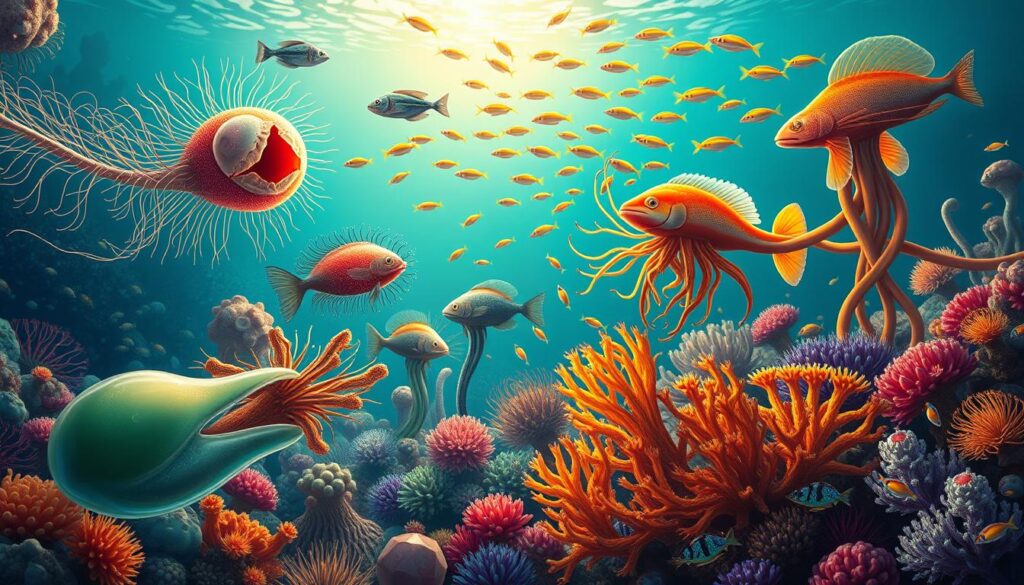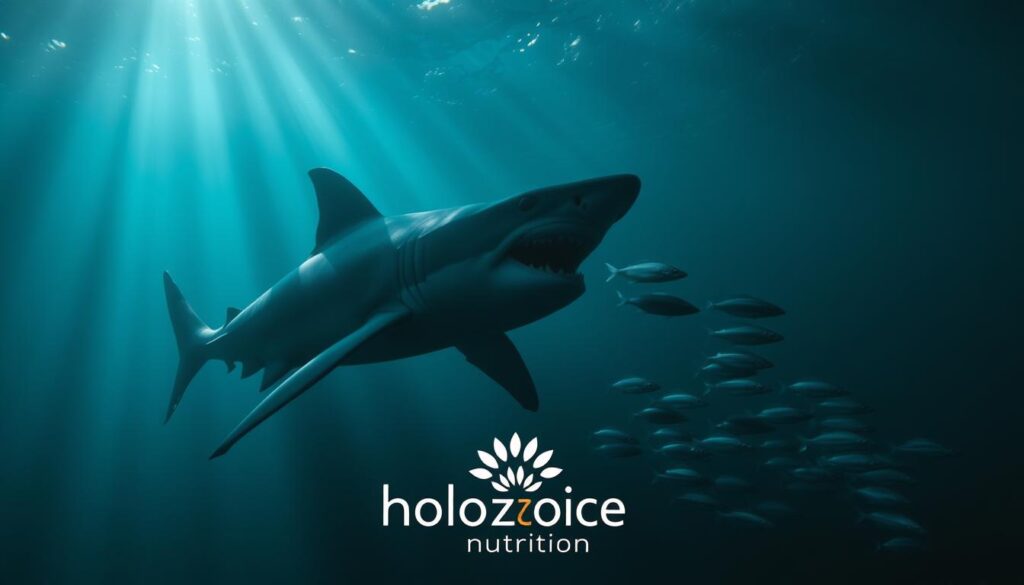Ever thought about how living things get the nutrients they need to live? Holozoic nutrition is a cool way to learn about how complex life forms get the animal-based nutrients they need. They use special ways to eat and digest food.
Heterotrophic nutrition is key for animals to get the energy and parts they need to survive. Unlike plants, animals can’t make their own food. So, they have to eat other things to get what they need.
The process of holozoic nutrition is very detailed. It starts with eating food and ends with breaking it down into simple parts. These parts are then used by cells in the body.
Key Takeaways
- Holozoic nutrition is a complex feeding mechanism used by many organisms
- Heterotrophic organisms rely on external food sources for survival
- Nutrient processing involves multiple sophisticated biological stages
- Animal-based nutrients are essential for metabolic functions
- Understanding nutrition helps improve overall health strategies
Understanding the Fundamentals of Holozoic Nutrition
Holozoic nutrition is a unique way for living things to get nutrients. It’s about heterotrophic organisms getting food directly from their surroundings. This shows how complex and varied life can be in different places.

Heterotrophic organisms can’t make their own food. They need to get it from outside themselves. They use different ways to get what they need:
- Predation: Active hunting and consuming other organisms
- Parasitism: Extracting nutrients from host organisms
- Symbiosis: Collaborative nutrient acquisition through mutual relationships
Key Components of Holozoic Feeding
The process of holozoic nutrition has important steps. These steps help organisms turn food into energy they can use. It shows how life can adapt in amazing ways.
| Feeding Strategy | Nutrient Acquisition Method | Energy Efficiency |
|---|---|---|
| Predation | Direct consumption of prey | High energy transfer |
| Parasitism | Nutrient extraction from host | Moderate energy transfer |
| Symbiosis | Cooperative nutrient exchange | Balanced energy distribution |
Cellular Processes in Nutrient Absorption
At the tiny cell level, getting nutrients is very complex. Heterotrophic organisms use special parts and enzymes. They break down food, make it useful, and spread energy through their bodies.
The Evolutionary Significance of Predatory Feeding

Predatory feeding is a key step in the growth of many species. Eating animal prey, or zoophagy, has pushed evolution forward in many places. It has helped species adapt to their environments in new ways.
The move to a carnivorous diet was a smart survival tactic. It changed how life forms interact with their surroundings. Natural selection made hunting and eating other animals a winning strategy. This led to complex relationships between predators and prey.
- Predatory feeding allowed organisms to get more energy from their food
- Complex hunting methods came about through the need to survive
- Special body parts developed to help catch and eat prey
Many species got better through the use of predatory feeding. Carnivorous diet innovations let them find new places to live and grow. This increased their chances of survival and added to their genetic variety.
Survival isn’t just about consuming food—it’s about developing the most efficient mechanisms to acquire and process nutritional resources.
In both the sea and on land, eating other animals has shaped life. The ways predators hunt and eat show nature’s amazing ability to adapt and survive.
Essential Mechanisms of Food Processing in Animal-Based Nutrition
The world of holozoic nutrition shows us how meat-eating organisms process their food. It’s a complex process that helps animals get the most nutrition from their diet.
Faunivory is a key survival strategy for many. It involves breaking down food and extracting nutrients. This process gives us deep insights into animal biology.
Ingestion and Mechanical Breakdown
The first step in processing nutrients is mechanical breakdown. Animals use different methods to prepare their food for digestion:
- Teeth grinding and crushing
- Muscular stomach contractions
- Physical fragmentation of food particles
Digestive Enzyme Activity
Special enzymes are key in breaking down food molecules. Different enzymes target different nutrients:
| Enzyme Type | Target Molecule | Breakdown Location |
|---|---|---|
| Protease | Proteins | Stomach and Small Intestine |
| Lipase | Fats | Small Intestine |
| Amylase | Carbohydrates | Mouth and Small Intestine |
Nutrient Absorption Pathways
The last step is absorbing nutrients through special cells. Selective permeability helps animals get the nutrients they need from their food.
- Intestinal wall absorption
- Cellular membrane transport
- Bloodstream distribution
These detailed processes show how efficient holozoic nutrition is. It supports animal survival and growth.
Exploring the Predator-Prey Relationship in Natural Ecosystems
The predator-prey relationship is key in nature, keeping ecosystems in balance. It’s more than just survival; it shapes how living things evolve in different places.
Predators are vital for healthy ecosystems. They do several important things:
- Keep prey populations in check
- Remove weak or sick individuals
- Stop plants from being overgrazed
- Help keep genetic diversity high
Energy moves up the food chain in these relationships. Primary consumers get energy from plants. Predators then get energy from these consumers. This flow of energy moves through different levels of the food chain.
Nature shows amazing ways for predators and prey to survive. For example, cheetahs are fast to catch prey, and gazelles are quick to avoid them.
Every predator-prey interaction represents a delicate balance between survival and ecological sustainability.
By studying these relationships, scientists learn about bigger ecological patterns. They also try to predict changes in the environment. They’re always looking into how these interactions affect biodiversity and how strong ecosystems are.
Benefits and Challenges of Holozoic Nutrition in Modern Diet
Understanding holozoic nutrition is complex. It involves knowing how we consume biomass and its effects on the environment. Today, we need smart ways to get nutrients and keep our metabolism healthy.
Optimal Nutrient Absorption Strategies
To get the most from holozoic nutrition, we should choose high-quality proteins. Here are some tips to improve your diet:
- Prioritizing lean protein sources
- Understanding individual metabolic requirements
- Balancing animal-based nutrition with diverse food groups
“Nutrition is not about perfection, but making informed choices that support overall wellness.” – Dr. Sarah Kumar, Nutritional Science Expert
Managing Dietary Requirements
Those following holozoic nutrition need to think about their own health needs. Personalized nutritional planning is key to handling challenges related to biomass.
Common Misconceptions
Many think holozoic nutrition is too strict. But it’s really about finding a balance. It focuses on eating in a way that’s good for you and the planet.
- Myth: Holozoic nutrition is extreme
- Reality: It’s a balanced nutritional approach
- Goal: Optimal health through informed choices
Learning about these nutrition basics helps us make better food choices. It’s about taking care of ourselves and the environment.
Ecological Impact and Sustainability of Flesh Consumption
The way we eat meat has a big impact on our planet. In places like India, where people are growing more, it’s especially important to think about this. Eating meat uses a lot of water, causes pollution, and harms the land.
To make our food choices better for the planet, we need to pick meat that’s kinder to the earth. Experts say we should eat a variety of proteins. This includes foods from farming that helps the environment and still meets our nutritional needs.
New ways to make meat and plant-based options are helping. These could be the answers to our environmental problems. They show us how to eat well without hurting the planet.
Knowing how our food choices affect the earth helps us make better choices. By choosing meat that’s better for the planet, we can help the environment. This is a big step towards a healthier and more sustainable food system for everyone.
FAQ
What exactly is holozoic nutrition?
Holozoic nutrition is how animals and some single-celled organisms eat. They break down solid food into nutrients. This process includes eating, digesting, absorbing, and getting rid of waste.
How does holozoic nutrition differ from other types of nutrition?
Holozoic nutrition is different from making food like plants do. It involves eating food from other living things. Animals and some single-celled organisms need to find and digest food from their surroundings.
What are the main stages of holozoic nutrition?
The main steps are eating, digesting, absorbing, using nutrients, and getting rid of waste. These steps help an organism get the nutrients it needs.
Are all animals holozoic nutritional organisms?
Yes, most animals are holozoic. This includes mammals, birds, reptiles, fish, and many invertebrates. They eat other organisms or organic matter, unlike plants.
How do predatory animals fit into holozoic nutrition?
Predatory animals are a key part of holozoic nutrition. They eat other animals to get nutrients. This helps energy move through ecosystems.
What role do digestive enzymes play in holozoic nutrition?
Digestive enzymes are very important. They break down food into smaller parts that can be absorbed. This helps the organism get the nutrients it needs.
Is holozoic nutrition sustainable from an environmental perspective?
The sustainability of holozoic nutrition depends on many things. Animal diets can harm the environment. But, understanding and using food wisely can help lessen these effects.
Can holozoic nutrition principles be applied to human dietary choices?
Yes, humans follow holozoic nutrition too. Knowing how our bodies process food helps us make better choices. This supports our health and well-being.
